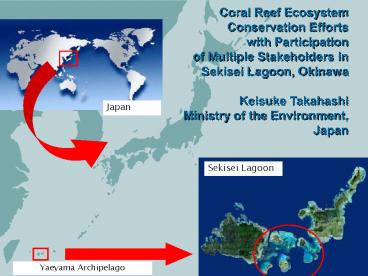Japan - PowerPoint PPT Presentation
1 / 14
Title:
Japan
Description:
... in natural resources management, time-flame design at the outset is important, ... The Committee should agree on Grand Design for the nature conservation ... – PowerPoint PPT presentation
Number of Views:22
Avg rating:3.0/5.0
Title: Japan
1
Coral Reef Ecosystem Conservation Efforts with
Participation of Multiple Stakeholders in
Sekisei Lagoon, Okinawa Keisuke
TakahashiMinistry of the Environment, Japan
Japan
Sekisei Lagoon
Yaeyama Archipelago
2
More that 360 Species of Hermatypic Corals are
found in Sekisei Lagoon
3
Variously used for fishery and tourism
4
Coral Reef in Sekisei Lagoon is degraded by
COTS Outbreak
Bleaching
Red Soil Runoffs
5
Ministry of the Environment Decided to launch the
nature restoration Project in Sekisei Lagoon with
Participation of Multiple Stakeholders
National Government Municipal Government Prefectur
e Government
Sugarcane/Pineapples farming causes red-soil
runoffs and stockbreeding causes seawater
pollution
Tourism Industry
Depend their livelihood on coral reefs Over
fishing causes decline of fish stock.
Tourism is the biggest industry in the area.
6
Dilemma 1In designing time-flame of the
participatory process
- Participation by local Stakeholders is imperative
for Coral Reef Management. - Participatory Approach requires long time to make
Actions. - Corals in Sekisei Lagoon are severely degraded
and we need immediate actions.
7
Measure takenTwo-Step Approach
Master Plan forNature Restoration(2005)
- Academic Experts
- Administrative Bodies
Nature Restoration Project in Sekisei
Lagoon (2005)
Nature Restoration Committee(2006) (Various
Stakeholders)
Grand Design for Nature Restoration
8
Dilemma 2In establishing the Stakeholders
Committee
- Local Residents have strong interests in Coral
Reef management. - Sometimes, They are not keen to participate in
the open discussion.
9
Measures takendeliberate communication
- lectures and workshops for local people
- Visiting local people individually to explain
objectives of the committee
Good relationship with local stakeholders Local
people well understand the objectives of the
committee.
10
We got About 100 bodies/individuals participate
the Committee.
11
Dilemma 3In managing discussion in the Committee
- To reflect views from various sectors, discussion
should be participated by many stakeholders. - When participants are too many, it is difficult
to discuss issues and reach agreements.
12
MeasuresGroup discussions
- Small Group Discussions
- Additional Thematic Working group
- All participants have their say
- Intensive discussion on certain issues
13
Lessons Learned
- When introducing a participatory processes in
natural resources management, time-flame design
at the outset is important, and in some cases,
two step approach-first start with small and easy
group, then expand the members-are recommended. - To involve local community, building relationship
of mutual trust is imperative, which many cases
takes long time. - To manage the discussion in large group, small
group discussion and Additional Thematic Working
group are useful tools.
14
Challenge
- The Committee should agree on Grand Design for
the nature conservation - The Committee needs to clarify each members role
in order to ensure the effectiveness of each
efforts. - The Committee Members need to share objectives
with local residents who are not engaged in the
Committee at this moment.































